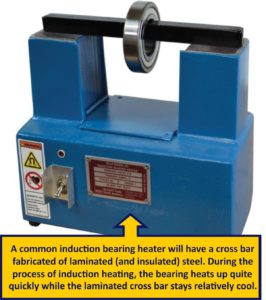Why is a Stator Core Made of Laminated Steel?
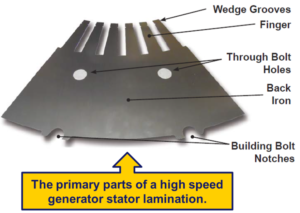 A turbogenerator stator is comprised of two major components: 1) the stator windings, and 2) the stator core. The stator core is made up of thousands, tens of thousands, or hundreds of thousands of individual steel laminations. Modern laminations are comprised of silica-steel, cold-rolled and grain-oriented as specific designs might require. The material is typically between 0.014″ to 0.018″ (29 to 26 gauge) thick and coated with a very thin layer of insulation, as little as 0.001″ thick.
A turbogenerator stator is comprised of two major components: 1) the stator windings, and 2) the stator core. The stator core is made up of thousands, tens of thousands, or hundreds of thousands of individual steel laminations. Modern laminations are comprised of silica-steel, cold-rolled and grain-oriented as specific designs might require. The material is typically between 0.014″ to 0.018″ (29 to 26 gauge) thick and coated with a very thin layer of insulation, as little as 0.001″ thick.
Stator core laminations have a very specific profile and the dimensions have exacting tolerances. Currently, laminations are manufactured by Punching/stamping dies, or Computer-controlled laser cutting machines.
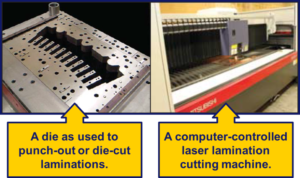
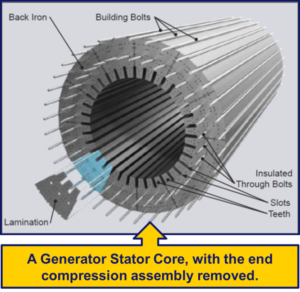 A stator core is built up as laminations are placed side-by-side in order to make a complete circular or ringed layer. The next layer is laid, offsetting each layer like a brick or cinder block wall. A stator core can easily be ten to twenty feet in length, at 0.014″ to 0.018″ per layer. It is no wonder that thousands of individual laminations are required. This enormous mass of steel segments is aligned and held together under compressive load with components such as key bars, building bolts, through bolts, finger plates, and compression rings.
A stator core is built up as laminations are placed side-by-side in order to make a complete circular or ringed layer. The next layer is laid, offsetting each layer like a brick or cinder block wall. A stator core can easily be ten to twenty feet in length, at 0.014″ to 0.018″ per layer. It is no wonder that thousands of individual laminations are required. This enormous mass of steel segments is aligned and held together under compressive load with components such as key bars, building bolts, through bolts, finger plates, and compression rings.
An energized turbine generator rotor creates an electromagnetic field with lines of force traveling from north pole to south pole very much like that of planet Earth.
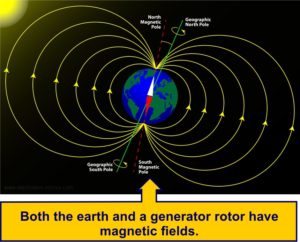
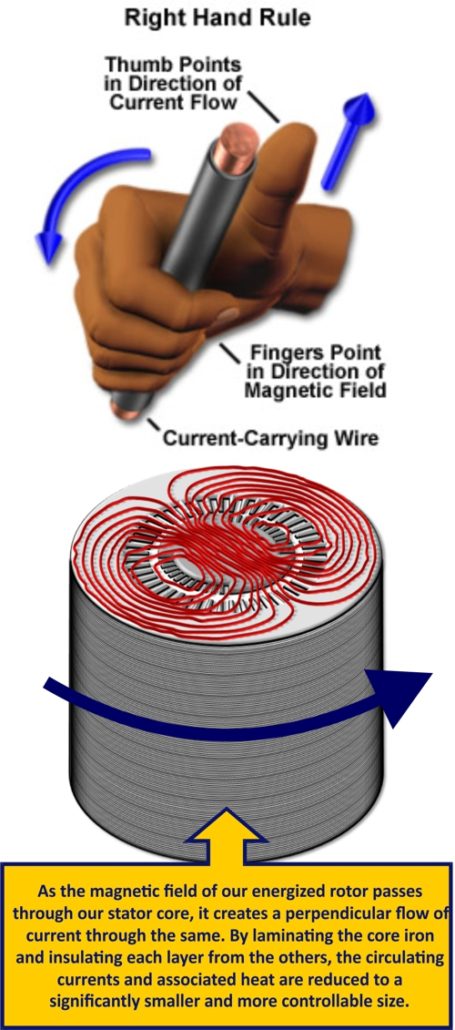 As the energized rotor rotates within the stator core, these lines of force travel through layers of laminations in a tangential direction. According to the laws of electromagnetism, a perpendicular magnetic field is created as a current flows through a conductor. Conversely, as the magnetic field of our energized rotor passes through our stator core, it creates a perpendicular flow of current through the stator. If our stator core were made from one solid piece of steel, these currents (known as circulating currents or eddy currents) and the associated heat generated would be huge. So huge in fact that the generator core would quite conceivably melt down. The circulating currents are reduced to a significantly smaller and more controllable size by laminating the core iron and insulating each layer from the others. The heat created by the currents can then be managed by pumping cooling gasses (air or hydrogen) across and/or through the core iron structure.
As the energized rotor rotates within the stator core, these lines of force travel through layers of laminations in a tangential direction. According to the laws of electromagnetism, a perpendicular magnetic field is created as a current flows through a conductor. Conversely, as the magnetic field of our energized rotor passes through our stator core, it creates a perpendicular flow of current through the stator. If our stator core were made from one solid piece of steel, these currents (known as circulating currents or eddy currents) and the associated heat generated would be huge. So huge in fact that the generator core would quite conceivably melt down. The circulating currents are reduced to a significantly smaller and more controllable size by laminating the core iron and insulating each layer from the others. The heat created by the currents can then be managed by pumping cooling gasses (air or hydrogen) across and/or through the core iron structure.
This same principle applies in other applications. Anyone who has used a common induction bearing heater will have noticed that the cross bar is fabricated of laminated (and insulated) steel. During the process of induction heating, the bearing heats up quite quickly while the cross bar stays relatively cool.
Simply stated a stator core is laminated and insulated in order to reduce induced circulating currents and associated heat down to a manageable level.
